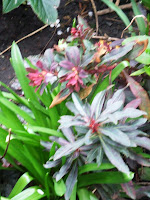Almost 7 years ago now, a friend gave me a garden token for a birthday present. I was delighted. (Few people buy me tokens, particularly book tokens. I believe they think that after a lifetime working with books the last thing I want as a present is more books, but they couldn’t be more wrong. I really enjoy deliberating what to chose and often have the token for quite some while before deciding. (A pleasant dilemma!)
Garden tokens similarly. In this particular case, however, I decided quite quickly that I’d prefer to buy something a bit different to remind me of my friend. I hit upon a medlar tree. They are out of fashion these days but I believe they were well known in Elizabethan times. The Victorians used the fruit as an after-dinner dessert, usually enjoyed with a glass of port. I’m not partial to port but liked the idea of growing an unusual fruit tree and duly chose a tree labelled, Medlar Nottingham, from a nearby nursery.
According to the Readers’ Digest's Food from Your Garden, the flowers are borne in early summer and the brown fruits are not to be harvested until late autumn after which they are to be left to ripen further until they become soft to the touch – a process known as ‘bletting’. They can be eaten raw, mixing the pulp with sugar and cream, or blended with cream and cider to make a medlar fool. Medlars can also be roasted in the oven and sweetened before eating, or made into a jelly in the same way that crab apple jelly is made.
I resigned myself to having to wait some time before the tree would come to fruition, as it were, so imagine my delight when, during the extremely mild April last year, I noticed that the tree was covered in delicate white flowers with just a hint of pink. When the weather suddenly changed for the worse the flowers seemed to vanish overnight and I thought no more about the tree, believing that the flowers wouldn’t have had an opportunity to be pollinated.
How wrong could I be? I was almost ecstatic when, late that summer, miraculously I noticed that what looked like a profusion of small green plums had appeared on the tree. Aware that the fruit of the medlar was not to be harvested until autumn, I took little further notice of them until late August when I realised that they had turned a lovely golden, almost ochre, colour. I gently touched one and it dropped into my hand. Puzzled, for it felt very soft, I took a bite – of an apricot! Sadly, most of the fruit was by this time too ripe to eat and over the next few days the fruit fell to the ground, a treat for the sugar-seeking wasps.
Not only did my tree produce apricots last year but magically, once again, my tree is in bloom! Learning from last year, I intend to be more vigilant this time and will harvest the fruit by the beginning of August. It will be amazing to be able to make jam and pies using my own home-grown apricots.
Apricots, natives of China, are notoriously difficult to grow in this country - other than in the south where they are usually grown as fan trees, trained against a south-facing wall in a sheltered position. In the north of England where I live they are only ever grown under glass.
Proof that there really are fairies at the bottom of Pablo’s garden?
I wonder!




















